Abstract
In the realm of sustainable construction, Life Cycle Assessment (LCA) plays a key role as a tool for quantifying the environmental impacts of building materials and products. The integration of LCA and Building Information Modeling (BIM) makes it possible to evaluate the environmental performance of buildings at the design stage. This integration can help to improve the LCA process for buildings thanks to the potential for automation and interoperability. The goal of this study is to establish a BIM-based LCA workflow using the Industry Foundation Classes (IFC) open file format. The interoperability of BIM data exchange is achieved by applying IFC. The steps of the assessment process are described in accordance with the LCA phases outlined in the ISO 14040 standard. The impact assessment and results interpretation phases are automated by means of a program code for IFC file processing. The proposed BIM-based LCA is validated for a case study of a BIM model constructed for a three-story educational building. The GWP of the building materials and products of envelope and load-bearing structures at the A1–A3 life cycle stages are calculated for the purpose of proposed workflow testing. The resulting workflow allows for the calculation of negative environmental impacts to be agile, depending on the goal and scope set.
1. Introduction
1.1. Present Context
The current environmental agenda in general, as well as in the construction sector in particular, generates sufficient demand in the civil engineering community for solutions aimed at reducing the global environmental damage from the life cycle of buildings [1]. Life Cycle Assessment (LCA) can provide valuable information about the environmental performance of buildings at different stages of their life cycle [2]. LCA results are extremely important at the pre-construction stage for engineers assessing the environmental impacts of their decisions, especially in terms of the selected building materials/products and the energy performance of buildings. Quantitative analysis of LCA results allows the design decisions to be optimized and made from a sustainability standpoint, using the obtained results as a starting point for optimization.
Building Information Modeling (BIM) is an invaluable tool for sustainable construction and design, mainly because of its basic principle that specific information can be fed to the entities within a digital model at the design stage, to be subsequently used for different kinds of model analysis (cost estimation and planning, sustainability performance, energy performance). The BIM is vastly more effective for building design than relying on manual calculations in LCA, offering numerous benefits, such as the automatic inventory of building materials (Bill of Materials (BoM), surface areas, and materials volume) [3].
However, as a wide variety of proprietary software is used in the AEC (Architecture, Engineering, and Construction) industry at different design stages of the building life cycle (architecture, structure, plumbing, HVAC), stringent requirements are imposed on data interoperability between the participants [4]. A positive aspect of today’s completely digitally oriented construction industry is that any project team can choose the appropriate software in the market which is best suited for the specific design goals. On the other hand, in terms of Sustainability Performance Assessment (SPA) (as well as in many other BIM uses), this may present a barrier impeding the implementation and widespread dissemination of a sustainable approach to building design.
The openBIM is a vendor-neutral concept intended for improving the accessibility, usability, and management of digital data in the built asset industry, developed by build-ing SMART [5,6]. The majority of the most popular AEC softwares support the open IFC (Industry Foundation Classes) format, for example: Autodesk Revit 2024, Tekla Structures 2024, Bentley Systems MicroStation 2024, Graphisoft ArchiCAD 27 (2023), Rhino 8.1 (2023), SOLIDWORKS 2024, and so on. An additional open schema is the Green Building XML (gbXML), available for BIM data transfer for the purposes of energy analysis.
The concept of openBIM offers the improved sharing of project information, supporting seamless collaboration for all project participants for the purpose of SPA, among others. A central part of openBIM, IFC, is a set of vendor-neutral digital descriptions of the built asset industry, as defined by ISO 16739, and which is key to efficient data exchange between different users of proprietary software [7].
1.2. Exisiting BIM-Based Approach to Building LCA
In today’s practice, the relationship between BIM and LCA most commonly consists of retrieving the quantitative data of the building’s elements as a Bill of Quantity (BoQ) from a digital model in a proprietary file format. Next, that quantitative data can be exported, for example, as an Excel spreadsheet to be used as the basis for SPA calculations [8,9,10,11,12]. This approach demands a sufficient amount of manual work with every iteration of this process and access to all kinds of software used in a project for the user operating the system.
Autodesk Revit is an example of a proprietary software, allowing design teams to write and run plugins and extensions so that practitioners can perform LCA directly from that software. One Click LCA Revit integration is an example of this: the plugin enables users to extract relevant data, such as material names, categories/classes, geometric data, and units, from their BIM models [13,14]. This approach is useful for optimizing the selection of building materials and products from a sustainability standpoint (the assessment of the environmental impact of embodied carbon and other indicators).
Reviewing the existing approaches to using the open format in the context of the environmental performance assessment of buildings, we can conclude that the general structure of a building’s LCA consists of three phases:
- Construction of a BIM model;
- Processing of the data contained in the model (based on the IFC format);
- Generation of reports on the completed assessment.
The difference between the existing methods and the one considered in this paper is in the approach taken to combining the environmental performance data of the BIM model elements (building materials, products, equipment) contained in the Environmental Product Declaration (EPD) and the model elements themselves. Moreover, the approach to processing model data in the open IFC format and the form of obtaining assessment results also differs from other studies.
The study by Zaid Alwan et al. [15] considered the benchmarking of greenhouse gas emissions from buildings at the design stage, serving as an example of using the open IFC format in the context of the environmental performance assessment of buildings. The authors developed a benchmarking tool allowing the calculation of embodied greenhouse gas emissions and compared them with target indicators.
The approach to the environmental assessment of buildings proposed by Bahriye Ilhan et al. [16] also adopted the IFC format for calculating negative environmental impact. Environmental data and model elements were combined in the study in an open data format after exporting them from the model in a proprietary software file format.
According to the paper by Fatma Abdelaal et al. [17], construction industry stakeholders note the importance of BIM/LCA integration to achieve sustainable development goals in the construction industry. BIM is still not implemented everywhere, while LCA is a much more uncommon practice in many countries around the world. Most existing methods for conducting the BIM-based LCA of buildings do not include an open format of digital information models, making this topic worthy of further exploration.
Jiayi Xu et al. described in detail the processes of BIM/LCA integration [18] for a case study of a prefabricated residential building in Hong Kong. The authors did not focus on using an open data format for BIM data exchange, defining a step-by-step methodology for carrying out various types of construction LCA.
The goal of this paper is to formulate a BIM-based LCA methodology by producing a BIM model of a building in the open IFC file format. The methodology should be interconnected with the LCA structure approved by the ISO 14040 [19] and ISO 14044 standards [20]. This goal is achieved by the following steps: (a) the construction of the workflow for the methodology and the links between its phases; (b) the description of the methodology phases by the constructed workflow; and (c) the BIM-based LCA of the educational building by the established methodology.
2. Materials and Methods
The process of LCA is described in the ISO 14040 [19] and ISO 14044 standards [20,21]. ISO 14040 outlines four interrelated phases, establishing that LCA results can be useful as initial data for decision-making in building design (Figure 1).
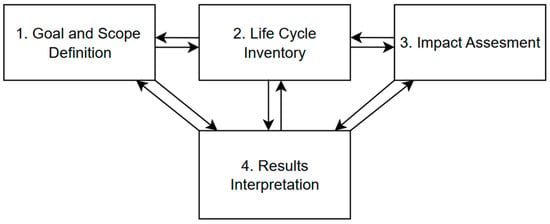
Figure 1.
LCA phases based on ISO 14040 [5].
The goal and scope definition phase is a definite advantage of the LCA scheme because it is agile and depends on the assessment goals and the amount of available data. Clearly, the goal of any assessment determines the complexity of the approaches and means by which it can be obtained. For example, if the goal is to obtain brief and approximate LCA results for the project (or part of it, depending on the scope), there is no need for methods with open file format processing. The model’s Level of Development (LOD) can determine the scope of the assessment and affects the accuracy of LCA results [22,23,24].
BIM technology makes it possible to introduce the BoQ into the above workflow with integrated BIM/LCA, serving as a basis for subsequent calculations of environmental impact assessment.
Figure 2 shows the schematic for the integration of BIM into the building LCA.
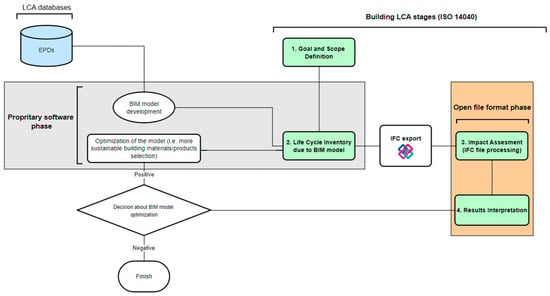
Figure 2.
Workflow for BIM-based LCA using open file format for impact assessment and result interpretation.
The workflow described in this paper allows for both the inclusion and exclusion of dynamic mapping between specific or generic LCA databases of building materials/products/equipment and elements of the evaluated BIM-model. The dynamic mapping between LCA data and model elements means that the attributes (environmental performance data) of the assessed model elements are constantly updated by the existing LCA databases of building materials, products, or equipment. Case studies with dynamic mapping between LCA databases and BIM models were carried out by R. Santos et al. [25,26,27] and others [22,28,29,30].
A static type of link was established between LCA databases and BIM model elements in the case study evaluated in this work (attribute values containing LCA data were assigned manually to the element parameters). Notably, this approach allowed for the reduction of the amount manual operations by initializing the parameter values for the project template created, using the same libraries of materials and elements for further evaluations.
As mentioned above, the most common approach to BIM-based LCA is the assessment with a static link between LCA databases and model elements, so that environmental data are manually attributed to the model elements, with subsequent data exported as Excel spreadsheets [23,24,31].
2.1. Goal and Scope Definition
The first step of the proposed assessment methodology (see Block 1 of the workflow in Figure 2) is to define the goal and scope. The scope of application is interrelated with the goal of the assessment. Both the goal and the scope are determined by the availability and quality of the input data, namely, the indicators of the negative environmental impact of construction materials and the products used in the project. The LOD of the assessed BIM model also imposes limitations on the goal and scope.
Generally, the goal of BIM-based LCA is determined by (1) the expected calculation results for one, several, or all environmental indicators of the construction materials/products presented in the EPDs; and (2) the limitations of the assessment system: namely, the list of materials/structures/parts of the assessment object.
The goal and scope set for our study consisted of assessing the embodied Global Warming Potential (GWP) (corresponding to phases A1–A3 of the building life cycle) for the building materials and products of the envelope and load-bearing structures of a three-story educational building (Figure 3). Table 1 summarizes the parameters of the building and the goal and scope of the assessment in accordance with EN 15804 [32]. The object of assessment was located in the city of St. Petersburg, Russia (continental climate zone).

Figure 3.
Object of assessment.

Table 1.
Initial data, goal, and scope definition.
2.2. Life Cycle Inventory: Model Preparation
The BIM model should be prepared for export into IFC file format. A peculiar aspect of the negative environmental impact assessment of the building life cycle is preparing the data to be attributed to the model elements, so it is important to ensure that all necessary values are available in IFC format.
The source code is written for the automated processing of the model in IFC format. To ensure the universal and correct working of the code with different BIM models, it is necessary to follow the rules established by proposed workflow:
- Rules for parameter settings (units, groupings, naming conventions);
- Requirements for the format of the data attributed to the model elements;
- Naming conventions for types/instances of category elements participating in the assessment in accordance with the established workflow.
2.2.1. Attribute Initialization
To avoid difficulties with encoding the content of the model file in IFC format, the parameters of the required model elements should be written in Latin alphabet. All parameters should be named following a user-defined order, such as in the case of this work (Figure 4).
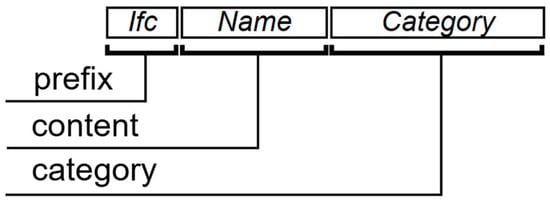
Figure 4.
Naming convention for parameters.
In this case, the parameters names follow the Pascal case convention and consist of three blocks. The content of the Category block depends on the approach to categorizing the model elements within each particular assessment.
The parameters presented in Table 2 were introduced based on the naming convention selected. It can be seen that the parameter names contain two categories of elements: (a) materials, i.e., building materials whose quantity is determined by surface area or volume (in the current assessment), and (b) products, i.e., building products whose quantity is determined by an integer numerical value (pieces). Quantitative indicators such as total area and volume are automatically calculated for each of the building materials in the model based on their surface area and thickness. Only one of these indicators is needed to calculate the environmental impact of a material. An additional parameter is introduced to unambiguously determine which indicator (area or volume) to use for calculating the negative environmental impact, characterizing the unit mass of specific greenhouse gas emissions per unit of measurement (area or volume) of the material quantity.

Table 2.
Initialized parameters.
BIM software automatically calculates the quantitative indicators of materials assigned to elements and stores them in the system parameters. However, these indicators are exported to IFC as user-defined parameters for convenient processing in the open file format in the proposed methodology. In Autodesk Revit, user-defined parameters are filled out automatically based on the values of system parameters, using the Dynamo interface.
As seen from the column listing the parameter names in Table 2 and the parameter naming convention adopted earlier, there are two element categories defined in this assessment: materials and products. The element categories are distributed into these two user-defined categories in accordance with the Autodesk Revit structure. Since the defined goal and scope specifies that the materials and products of building envelopes and load-bearing structures should be evaluated, only envelopes such as windows and doors are classified as products (in view of the LOD assigned for the BIM model in the case study).
Generic values from the international EPD database [33] are taken as GWP data for the evaluated building materials and products in this study.
2.2.2. Environmental Indicator Values: EPD Databases
The values of the negative environmental impact indicators are stored as the parameters assigned to construction materials and product categories. These values should be obtained from reliable sources. The Environmental Product Declaration (EPD) is an ISO type III Environmental Declaration complying with ISO 14025 [34], quantifying the environmental performance data over the product life cycle as verified by third parties. EPDs are issued by the manufacturer and verified by the International EPD System. Potentially, other Type III Environmental Declarations complying with ISO 14025 can also be used to obtain the required environmental performance values.
To calculate the impacts in view of the defined goal and scope, it is necessary to assign the values of negative environmental impact indicators to the evaluated building materials and products in accordance with the data of environmental declarations for the existing materials from publicly available EPDs.
2.2.3. Parameter Value Setting
The content of the IFC file is processed by attributing data to the model elements in accordance with the defined rules. The methodology provides the naming convention for the text parameter IfcNameMaterials (Figure 5). The name of each material has a block corresponding to the Revit category of the structural elements to which the material belongs. This is necessary for the subsequent filtering of the materials by the category to which they belong as well as for retrieving the environmental impact data about specific element categories in comparison with the others.
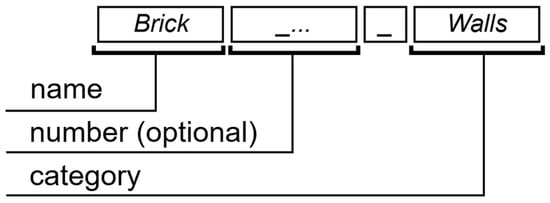
Figure 5.
Naming convention for parameter IfcNameMaterials.
The proposed approach to assigning categories to the materials used in a project based on the type of structure they are associated may yield different results depending on the LCA practitioner.
The data corresponding to the attributes defined in Table 2 are shown in Table 3 for all model elements of the materials category.

Table 3.
Values of material properties.
As seen from Table 4, the initialized attributes are filled with values for all elements of the model from the user-defined category products. Unlike the parameter IfcNameMaterials, the filling of the parameter IfcNameProducts is not formalized within the workflow proposed for this study because it is not necessary for further model processing in open IFC format.

Table 4.
Calculations of embodied GWP for materials and types of structures considered.
Calculation results are listed in Table 4.
2.3. Impact Assessment
The successful export of the BIM model to IFC format from proprietary software for constructing information models depends on the correct export settings.
2.3.1. IFC Format File Version
Versions of the IFC schema may differ depending on several factors, in particular, the specific content of the IFC file. The BIM model in our case study is exported into IFC 4.3 version for further processing.
2.3.2. User-Defined Property Sets
The user-defined properties of model elements are grouped into sets, regulating the export of values to the IFC file. For further processing of the user-defined element properties of the model in IFC format, a text file containing information about the sets of these properties and their representation in the IFC file is generated. The structure established for the contents of this file must be followed. The data type is specified for each user-defined parameter, along with the IFC of elements to which this parameter belongs. Figure 6 shows the structure of this text file containing user-defined property sets as well as the property sets relevant for this work (taking into account the parameters presented in Table 4).

Figure 6.
Structure of user-defined property sets.txt file.
2.3.3. Table Export
It is convenient to export the necessary information about the model elements to IFC format using tables (specifications) created in advance in the proprietary modeling software. In the case of Autodesk Revit software in particular, each specification created for the categories of model elements involved in the assessment can be exported to an IFC file. Exporting the specifications is an alternative to the previous method of exporting customized parameter data (creating a file with user-defined property sets).
Tables containing the necessary properties are a convenient format for further data processing for the assessment of negative environmental impact without using the open data format of IFC information models. Such specifications can be exported as Excel spreadsheets and further processed there. This methodology of building LCA is applicable if the practitioner performing the assessment has access to proprietary model formats and the appropriate modeling software.
2.4. Impact Assessment Due to IFC File Processing
The exported BIM model file in IFC format is subject to automated processing to generate reports. Reports summarize the results for the negative environmental impact of the object assessed within the established goal and scope. File processing is performed using the python 3.10.5. IfcOpenShell is an open-source software library providing a toolkit that developers can use to read, analyze, and edit digital BIM models in the open IFC format. This library is available in programming languages such as python and C++.
The purpose of IFC file processing in the context of this work is to calculate the quantitative indicators of the building’s negative environmental impact at certain stages of its life cycle, taking into account the defined goal and scope. The calculation results should be presented in an easy-to-read format. The written program should allow the calculation to be conducted and its results to be obtained automatically, based on the IFC file previously prepared in compliance with the proposed workflow.
Figure 7 shows a detailed scheme for the part of the workflow (Figure 2) describing the operations in the open format. The segment for the processing of the model in IFC format (3: impact assessment, and 4: results interpretation) is divided by the key points presented in the figure.

Figure 7.
IFC file processing scheme.
The BIM model of the building is sent to the impact assessment phase in open IFC format. Then, the working file is opened using the ifcopenshell library. The quantitative data of the model elements involved in the assessment and data on their ecological performance are extracted using the tools of this module. Extracted data are placed in a separate data container, dataframe, which is a data structure of the Pandas library for data analysis and processing. The data are extracted into tables (of the dataframe type) whose columns and rows can be used to calculate the quantitative indicators of the negative environmental impact of the assessed BIM model elements.
At the results interpretation phase, the calculation results are visualized as graphs and tables. The results are obtained using the matplotlib library for data visualization.
3. Results
Results Interpretation
The results of the environmental assessment conducted within the proposed framework for the case study of the building in IFC format can be visualized as graphs and tables. Figure 8 shows a pie chart of the embodied GWP calculation for each type of structure considered for assessment.

Figure 8.
Embodied GWP calculated for each type of structure.
Figure 9 shows the results of the embodied GWP calculation for all building materials and products considered in the goal and scope definition section. Since the assessment within the defined goal and scope covers a single environmental indicator (GWP) at phases A1–A3 of the building life cycle, the report consists of graphs and tables showing the calculation results for this single indicator. Other environmental indicators (ozone layer depletion (ODP), eutrophication potential (EP-terrestrial), water deprivation potential (WDP) and so on) could be taken into account in a similar way and can be included in the assessment: the attributes necessary for the calculation are then added to the model elements and a specific program code (expanding the existing one) is written to process them.

Figure 9.
Embodied GWP calculations for materials and products considered: (a) percentage; and (b) kg CO2 eq.
Additionally, the calculation results are shown as a bar chart in Figure 10.
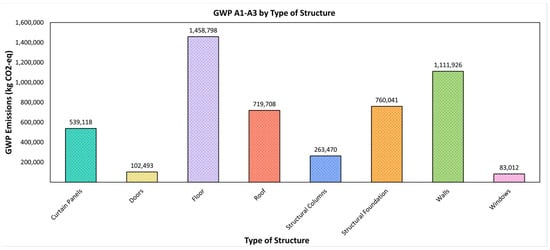
Figure 10.
Bar chart of embodied GWP calculated for each type of structure.
4. Discussion
The BIM-based LCA of an educational building was conducted in accordance with the established workflow (Figure 2) using the open IFC file format. The workflow established in this paper allowed us to conduct flexible LCA depending on the specific goal and scope.
Advantages of using an open data format for BIM-based LCA:
- The open format for BIM data exchange offers a defined and standardized structure for the content of BIM models, allowing for a unified approach to impact assessments and their automation.
- The open format for representing BIM data is a central aspect of the openBIM concept. Using an open format (IFC) increases data interoperability between the participants of the design process. It follows from this that using an open format for the needs of building LCA allows the practitioners to be independent of the proprietary software.
- Processing the BIM model in IFC format using program code allows both the unification of the assessment procedure and the improvement of the flexibility of BIM-based LCA. The model can be customized for the specific requirements based on the goals set. Moreover, this approach to processing model data allows the generation of different assessment scenarios, for example, different programs for processing IFC files to obtain environmental indicators at different stages of the building’s life cycle.
The disadvantages of the proposed method include the following:
- The part of the process when the BIM model is prepared for export to IFC format in accordance with our workflow requires a sufficient amount of manual operations (due to the current lack of dynamic mapping between LCA databases and elements of the BIM model).
- The LCA practitioner must have the skills to write and adjust the program code using Python and must be familiar with the file structure and hierarchy of IFC. This drawback can be solved by creating a desktop app with a clear user interface.
- There are a lack of available BIM element libraries with LCA data and a lack of consensus on how to structure LCA data and profiles.
To verify the accuracy of the calculations, a control calculation was performed using the One Click LCA program [13], applying the same quantity of materials/products. The aim of the verification was to achieve comparable results for CO2 eq. calculations at stages A1–A3 of the building life cycle, using the same initial data (Bill of Materials derived from BIM model, defined scope). It should be noted that the GWP indicators per unit of material in the case study were generic. Therefore, in order to make the results of the calculation by the two methods approximately equal, the goal was set to find existing materials in the One Click LCA program with A1–A3-specific GWP that closely matched the generic values used in the case study.
Additionally, the categorization of materials/products in One Click LCA differs from the categorization of materials/products in this paper. While this difference does not affect the calculation results, it does influence the interpretation of the reports. It was necessary to make a comparison of the results, taking into account different approaches to material categorization.
The comparison of the results is presented in Table 5:

Table 5.
Comparison of the results of the assessment approaches.
The total GWP values are different because of the minor discrepancies between the environmental indicators used in the One Click LCA product EPD and those of this case-study. The most notable difference in the categories ‘Glass wool insulation’ and ‘Mineral wool’ can be seen due to difference in A1–A3 stage GWP indicator values.
The approbation of the proposed method on another BIM model (Figure 11) not only allowed for the validity of the proposed method to be checked, but also for the time required to conduct the LCA to be estimated. For this building, 1 h and 15 min were spent to prepare the model for further processing in the open data format (inventory analysis stage) according to proposed method. The IFC file of a BIM-model was created using the established settings. As no adjustments were needed for our Python script, the impact assessment and results interpretation stages were completed automatically (in a matter of seconds). The initial data for assessment are presented in Table 6.
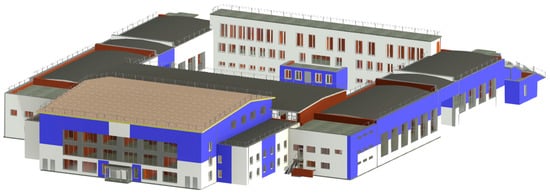
Figure 11.
Object of assessment (University Sports Center).

Table 6.
Initial data and goal and scope definition (University Sports Center).
Figure 12 shows the results of the embodied GWP calculation for all building materials and products used in this building.
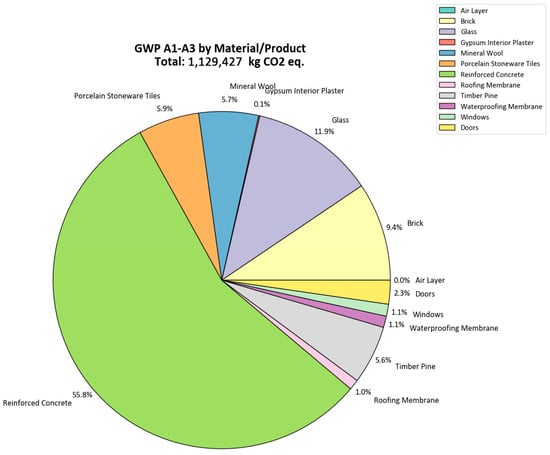
Figure 12.
Embodied GWP calculations for materials and products used in University Sports Center (percentage).
A comparison table has been created based on an analysis of existing practices and the method proposed in this paper (Table 7).

Table 7.
Comparative table of building LCA practices.
L. Wastiels and R. Decuypere [35] consider five existing strategies for integrating LCA into BIM. The workflow of the fifth strategy (BIM objects enriched with LCA data as a basis for assessment) corresponds to our methodological framework, since the elements of the BIM model are supplied with LCA data precisely at the modeling stage. The authors note that the choice of a particular strategy (methodology) depends on the objectives of the assessment, as well as on the stage of the project life cycle at which this assessment is performed.
Existing BIM-based LCA case studies follow the same general workflow, which consists of constructing the BIM model, linking its elements to LCA data, and conducting impact assessments, visualization, and analysis of the results. The difference between studies lies in the approaches to these phases [35,36].
As an example, consider the approach to BIM-LCA that was taken by Cheng, B et al. [37]. The greenhouse gas emissions and energy consumption of the object were assessed during its life cycle (cradle-to-grave). In this case, the assessment was made based on a BIM model created in Autodesk Revit and then exported to the open gbXML (Green Building XML) format. The results were obtained using the DesignBuilder software for environmental performance assessment. A similar method was proposed by Tsikos, M and Negendahl, K [38]. The authors proposed using Autodesk Revit to link the LCA databases and BIM model elements in the Dynamo environment after the modeling stage (rather than during it, as was the case in this work). This helps to eliminate the step when the environmental performance data are attributed to BIM model elements and establish dynamic mapping between LCA data and BoQ.
Parametric LCA frameworks are also proposed [39,40], constructing parametric models for the optimization of design solutions based on the assessment results [36].
BIM-based LCA methods are promising in the context of green building certification systems [41,42,43]. In particular, the study by Veselka, J [44] considered the application of a BIM-based LCA method for the most famous certification systems in the world, such as BREEAM, LEED, and DGNB.
5. Conclusions
The BIM-based LCA methodology for buildings proposed in this paper consists of four steps corresponding to the LCA phases described in ISO 14040. The proposed workflow was validated for a case study comprising a BIM model of an educational building. The goal and scope defined for the assessment determine the content of the subsequent phases. The life cycle inventory phase consists of preparing the model in the software environment for export into open format. The impact assessment and the results interpretation phases are based on a model in the open IFC format, processed using program code written in the Python programming language.
The negative environmental impact of building structures is calculated with respect to the selected environmental criteria by the described workflow. The proposed process of BIM/LCA allows for the automation of the impact assessment and result interpretation phases without depending on proprietary software, thanks to the IFC file format.
The proposed methodology can be significantly improved (a) in terms of establishing dynamic (real-time) mapping between LCA databases and BIM model elements; (b) by creating a user interface for the IFC file processing program and displaying the assessment results (computer application); and (c) by developing a mechanism for comparing the assessment results with existing target indicators (benchmarking).
Author Contributions
Conceptualization, D.Z., K.S. and M.P.; methodology, D.Z., K.S., E.M. and D.K.; software, D.K. and E.M.; validation, D.K., D.Z. and K.S.; formal analysis, D.Z., K.S., E.M. and D.K.; investigation, D.Z., K.S., E.M. and D.K.; writing—original draft preparation, D.K., D.Z. and K.S.; writing—review and editing, M.P., D.Z. and K.S.; visualization, D.K. and E.M.; supervision, K.S., M.P. and D.Z.; project administration, M.P. and K.S. All authors have read and agreed to the published version of the manuscript.
Funding
The research was funded under the strategic academic leadership program “Priority 2030”.
Institutional Review Board Statement
Not applicable.
Informed Consent Statement
Not applicable.
Data Availability Statement
The data presented in this study are available on request from the corresponding author.
Conflicts of Interest
The authors declare no conflicts of interest.
Correction Statement
This article has been republished with a minor correction to the Funding statement. This change does not affect the scientific content of the article.
References
- Obrecht, T.P.; Röck, M.; Hoxha, E.; Passer, A. BIM and LCA Integration: A Systematic Literature Review. Sustainability 2020, 12, 5534. [Google Scholar] [CrossRef]
- Sharma, A.; Saxena, A.; Sethi, M.; Shree, V. Varun Life cycle assessment of buildings: A review. Renew. Sustain. Energy Rev. 2011, 15, 871–875. [Google Scholar] [CrossRef]
- Soust-Verdaguer, B.; Llatas, C.; García-Martínez, A. Critical review of bim-based LCA method to buildings. Energy Build. 2017, 136, 110–120. [Google Scholar] [CrossRef]
- Gerbino, S.; Cieri, L.; Rainieri, C.; Fabbrocino, G. On BIM Interoperability via the IFC Standard: An Assessment from the Structural Engineering and Design Viewpoint. Appl. Sci. 2021, 11, 11430. [Google Scholar] [CrossRef]
- OpenBIM-buildingSMART. Available online: https://www.buildingsmart.org/about/openbim/ (accessed on 29 July 2021).
- Jiang, S.; Jiang, L.; Han, Y.; Wu, Z.; Wang, N. OpenBIM: An Enabling Solution for Information Interoperability. Appl. Sci. 2019, 9, 5358. [Google Scholar] [CrossRef]
- ISO 16739-1:2024; Industry Foundation Classes (IFC) for Data Sharing in the Construction and Facility Management Industries. Part 1: Data Schema. ISO: Geneva, Switzerland, 2024.
- Ajayi, S.O.; Oyedele, L.O.; Ceranic, B.; Gallanagh, M.; Kadiri, K.O. Life cycle environmental performance of material specification: A BIM-enhanced comparative assessment. Int. J. Sustain. Build. Technol. Urban Dev. 2015, 6, 14–24. [Google Scholar] [CrossRef]
- Basbagill, J.; Flager, F.; Lepech, M.; Fischer, M. Application of life-cycle assessment to early stage building design for reduced embodied environmental impacts. Build. Environ. 2013, 60, 81–92. [Google Scholar] [CrossRef]
- Georges, L.; Haase, M.; Houlihan Wiberg, A.; Kristjansdottir, T.; Risholt, B. Life cycle emissions analysis of two nZEB concepts. Build. Res. Inf. 2014, 43, 82–93. [Google Scholar] [CrossRef]
- Wiberg, A.H.; Georges, L.; Dokka, T.H.; Haase, M.; Time, B.; Lien, A.G.; Mellegård, S.; Maltha, M. A net zero emission concept analysis of a single-family house. Energy Build. 2014, 74, 101–110. [Google Scholar] [CrossRef]
- Kokaya, D.V.; Zaborova, D.D.; Koriakovtseva, T.A. Environmental analysis of residential exterior wall construction in temperate climate. Mag. Civ. Eng. 2023, 124, 12410. [Google Scholar] [CrossRef]
- One Click LCA. Available online: https://oneclicklca.com/en/resources/software-news/life-cycle-assessment-from-revit (accessed on 26 December 2024).
- Kamari, A.; Kotula, B.M.; Schultz, C.P.L. A BIM-based LCA tool for sustainable building design during the early design stage. Smart Sustain. Built Environ. 2022, 11, 217–244. [Google Scholar] [CrossRef]
- Alwan, Z.; Jones, B.I. IFC-based embodied carbon benchmarking for early design analysis. Autom. Constr. 2022, 142, 104505. [Google Scholar] [CrossRef]
- Ilhan, B.; Yaman, H. Green building assessment tool (GBAT) for integrated BIM-based design decisions. Autom. Constr. 2016, 70, 26–37. [Google Scholar] [CrossRef]
- Abdelaal, F.; Guo, B.H. Stakeholders’ perspectives on BIM and LCA for green buildings. J. Build. Eng. 2021, 48, 103931. [Google Scholar] [CrossRef]
- Xu, J.; Teng, Y.; Pan, W.; Zhang, Y. BIM-integrated LCA to automate embodied carbon assessment of prefabricated buildings. J. Clean. Prod. 2022, 374, 133894. [Google Scholar] [CrossRef]
- ISO 14040-2006; Environmental Management—Life Cycle Assessment—Principle and Framework. ISO: Geneva, Switzerland, 2006.
- ISO 14044-2006; Environmental management—Life Cycle Assessment—Requirements and Guidelines. ISO: Geneva, Switzerland, 2006.
- Finkbeiner, M.; Inaba, A.; Tan, R.; Christiansen, K.; Klüppel, H.-J. The New International Standards for Life Cycle Assessment: ISO 14040 and ISO 14044. Int. J. Life Cycle Assess. 2006, 11, 80–85. [Google Scholar] [CrossRef]
- Lee, S.; Tae, S.; Roh, S.; Kim, T. Green Template for Life Cycle Assessment of Buildings Based on Building Information Modeling: Focus on Embodied Environmental Impact. Sustainability 2015, 7, 16498–16512. [Google Scholar] [CrossRef]
- Cavalliere, C.; Habert, G.; Dell’Osso, G.R.; Hollberg, A. Continuous BIM-based assessment of embodied environmental impacts throughout the design process. J. Clean. Prod. 2019, 211, 941–952. [Google Scholar] [CrossRef]
- Nawrocka, N.; Machova, M.; Jensen, R.L.; Kanafani, K.; Birgisdottir, H.; Hoxha, E. Influence of BIM’s level of detail on the environmental impact of buildings: Danish context. Build. Environ. 2023, 245, 110875. [Google Scholar] [CrossRef]
- Santos, R.; Costa, A.A.; Silvestre, J.D.; Pyl, L. Development of a BIM-based Environmental and Economic Life Cycle Assessment tool. J. Clean. Prod. 2020, 265, 121705. [Google Scholar] [CrossRef]
- Santos, R.; Costa, A.A.; Silvestre, J.D.; Vandenbergh, T.; Pyl, L. BIM-based life cycle assessment and life cycle costing of an office building in Western Europe. Build. Environ. 2020, 169, 106568. [Google Scholar] [CrossRef]
- Santos, R.; Costa, A.A.; Silvestre, J.D.; Pyl, L. Integration of LCA and LCC analysis within a BIM-based environment. Autom. Constr. 2019, 103, 127–149. [Google Scholar] [CrossRef]
- Naneva, A.; Bonanomi, M.; Hollberg, A.; Habert, G.; Hall, D. Integrated BIM-Based LCA for the Entire Building Process Using an Existing Structure for Cost Estimation in the Swiss Context. Sustainability 2020, 12, 3748. [Google Scholar] [CrossRef]
- Soust-Verdaguer, B.; Gutiérrez, J.A.; Llatas, C. Development of a Plug-In to Support Sustainability Assessment in the Decision-Making of a Building Envelope Refurbishment. Buildings 2023, 13, 1472. [Google Scholar] [CrossRef]
- Meex, E.; Hollberg, A.; Knapen, E.; Hildebrand, L.; Verbeeck, G. Requirements for applying LCA-based environmental impact assessment tools in the early stages of building design. Build. Environ. 2018, 133, 228–236. [Google Scholar] [CrossRef]
- Crippa, J.; Boeing, L.C.; Caparelli, A.P.A.; da Costa, M.d.R.d.M.M.; Scheer, S.; Araujo, A.M.F.; Bem, D. A BIM–LCA integration technique to embodied carbon estimation applied on wall systems in Brazil. Built Environ. Proj. Asset Manag. 2018, 8, 491–503. [Google Scholar] [CrossRef]
- CEN EN 15804:2012+A2:2019/AC-2021; Sustainability of Construction Works-Environmental Product Declarations-Core Rules for the Product Category of Construction Products. CEN: Brussels, Belgium, 2019.
- The International EPD System. Available online: https://www.environdec.com/ (accessed on 27 December 2024).
- ISO 14025-2006; Environmental labels and declarations—Type III environmental declarations—Principles and procedures. ISO: Geneva, Switzerland, 2006.
- Wastiels, L.; Decuypere, R. Identification and comparison of LCA-BIM integration strategies. IOP Conf. Ser. Earth Environ. Sci. 2019, 323, 012101. [Google Scholar] [CrossRef]
- Chen, Z.; Chen, L.; Zhou, X.; Huang, L.; Sandanayake, M.; Yap, P.-S. Recent Technological Advancements in BIM and LCA Integration for Sustainable Construction: A Review. Sustainability 2024, 16, 1340. [Google Scholar] [CrossRef]
- Cheng, B.; Li, J.; Tam, V.W.Y.; Yang, M.; Chen, D. A BIM-LCA Approach for Estimating the Greenhouse Gas Emissions of Large-Scale Public Buildings: A Case Study. Sustainability 2020, 12, 685. [Google Scholar] [CrossRef]
- Tsikos, M.; Negendahl, K. Sustainable Design with Respect to LCA Using Parametric Design and BIM Tools. In Proceedings of the World Sustainable Built Environment Conference 2017, Wan Chai, Hong Kong, 5–7 June 2017. [Google Scholar]
- Hussain, M.; Zheng, B.; Chi, H.-L.; Hsu, S.-C.; Chen, J.-H. Automated and continuous BIM-based life cycle carbon assessment for infrastructure design projects. Resour. Conserv. Recycl. 2022, 190, 106848. [Google Scholar] [CrossRef]
- Mowafy, N.; El Zayat, M.; Marzouk, M. Parametric BIM-based life cycle assessment framework for optimal sustainable design. J. Build. Eng. 2023, 75, 106898. [Google Scholar] [CrossRef]
- Al-Ghamdi, S.G.; Bilec, M.M. Life-Cycle Thinking and the LEED Rating System: Global Perspective on Building Energy Use and Environmental Impacts. Environ. Sci. Technol. 2015, 49, 4048–4056. [Google Scholar] [CrossRef] [PubMed]
- Jalaei, F.; Jrade, A. Integrating building information modeling (BIM) and LEED system at the conceptual design stage of sustainable buildings. Sustain. Cities Soc. 2015, 18, 95–107. [Google Scholar] [CrossRef]
- Alshamrani, O.S.; Galal, K.; Alkass, S. Integrated LCA–LEED sustainability assessment model for structure and envelope systems of school buildings. Build. Environ. 2014, 80, 61–70. [Google Scholar] [CrossRef]
- Veselka, J.; Nehasilová, M.; Dvořáková, K.; Ryklová, P.; Volf, M.; Růžička, J.; Lupíšek, A. Recommendations for Developing a BIM for the Purpose of LCA in Green Building Certifications. Sustainability 2020, 12, 6151. [Google Scholar] [CrossRef]
Disclaimer/Publisher’s Note: The statements, opinions and data contained in all publications are solely those of the individual author(s) and contributor(s) and not of MDPI and/or the editor(s). MDPI and/or the editor(s) disclaim responsibility for any injury to people or property resulting from any ideas, methods, instructions or products referred to in the content. |
© 2025 by the authors. Licensee MDPI, Basel, Switzerland. This article is an open access article distributed under the terms and conditions of the Creative Commons Attribution (CC BY) license (https://creativecommons.org/licenses/by/4.0/).